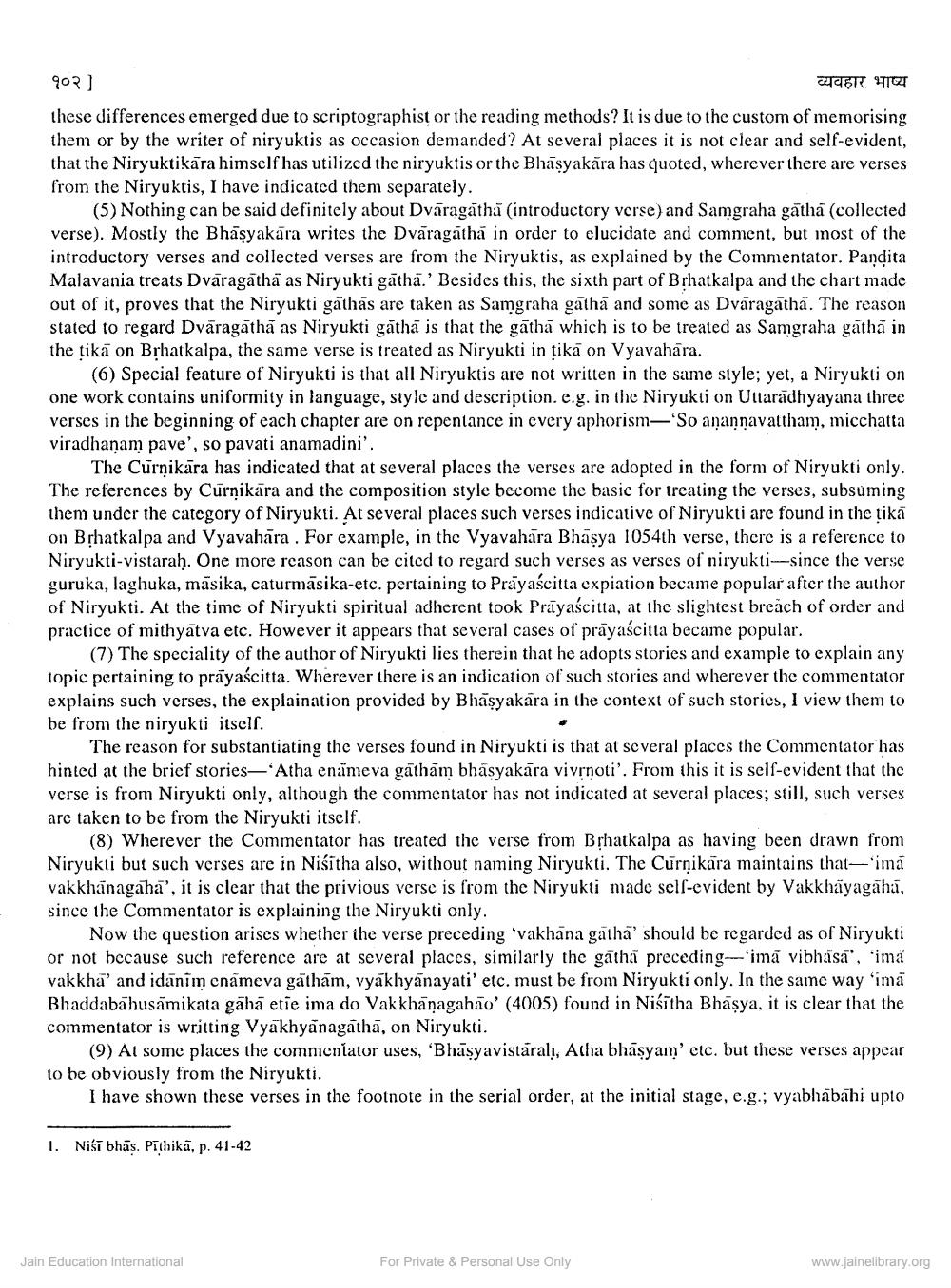________________
902)
व्यवहार भाष्य these differences emerged due to scriptographist or the reading methods? It is due to the custom of memorising them or by the writer of niryuktis as occasion demanded? At several places it is not clear and self-evident, that the Niryuktikāra himself has utilized the niryuktis or the Bhasyakára has quoted, wherever there are verses from the Niryuktis, I have indicated them separately.
(5) Nothing can be said definitely about Dvāragathā (introductory verse) and Samgraha gātha (collected verse). Mostly the Bhasyakāra writes the Dvaragatha in order to elucidate and comment, but inost of the introductory verses and collected verses are from the Niryuktis, as explained by the Commentator. Pandita Malavania treats Dvāragathā as Niryukti gātha.' Besides this, the sixth part of Brhatkalpa and the chart made out of it, proves that the Niryukti gathas are taken as Samgraha gatha and some as Dvaragatha. The reason stated to regard Dvāragatha as Niryukti gātha is that the gāthā which is to be treated as Samgraha gathā in the tikā on Brhatkalpa, the same verse is treated as Niryukti in ţika on Vyavahara.
(6) Special feature of Niryukti is that all Niryuktis are not written in the same style; yet, a Niryukti on one work contains uniformity in language, style and description. e.g. in the Niryukti on Uttaradhyayana three verses in the beginning of each chapter are on repentance in every aphorism— 'So anannavattham, micchatta viradhanam pave', so pavati anamadini'.
The Curņikāra has indicated that at several places the verses are adopted in the form of Niryukti only. The references by Cūrnikāra and the composition style become the basic for treating the verses, subsuming them under the category of Niryukti. At several places such verses indicative of Niryukti are found in the tikā on Brhatkalpa and Vyavahāra . For example, in the Vyavahara Bhasya 1054th verse, there is a reference to Niryukti-vistarah. One more reason can be cited to regard such verses as verses of niryukti---since the verse guruka, laghuka, māsika, caturmāsika-etc. pertaining to Prayascitta cxpiation became popular after the author of Niryukti. At the time of Niryukti spiritual adherent took Prayascitta, at the slightest breach of order and practice of mithyātva etc. However it appears that several cases of prāyaścitta became popular.
(7) The speciality of the author of Niryukti lies therein that he adopts stories and example to explain any topic pertaining to prayaścitta. Wherever there is an indication of such stories and wherever the commentator explains such verses, the explaination provided by Bhasyakara in the context of such stories, I view them to be from the niryukti itself.
The reason for substantiating the verses found in Niryukti is that at several places the Commentator has hinted at the brief stories—'Atha enāmeva gātham bhasyakāra vivrnoti'. From this it is self-evident that the verse is from Niryukti only, although the commentator has not indicated at several places, still, such verses are taken to be from the Niryukti itself.
(8) Wherever the Commentator has treated the verse from Brhatkalpa as having been drawn from Niryukti but such verses are in Nišitha also, without naming Niryukti. The Curņikara maintains that—'imā vakkhānagaha', it is clear that the privious verse is from the Niryukti made sell-evident by Vakkhayagāhū, since the Commentator is explaining the Niryukti only.
Now the question arises whether the verse preceding 'vakhāna gatha' should be regarded as of Niryukti or not because such reference are at several places, similarly the gathā preceding-imā vibhāsā', 'ima vakkha' and idanim cnameva gatham, vyakhyānayati' etc. must be from Niryukti only. In the same way 'ima Bhaddabāhusāmikata gāhā etie ima do Vakkhāṇagahão' (4005) found in Niśītha Bhāșya, it is clear that the commentator is writting Vyakhyanagatha, on Niryukti.
(9) At some places the commentator uses, 'Bhasyavistarah, Atha bhasyam'ctc. but these verses appear to be obviously from the Niryukti.
I have shown these verses in the footnote in the serial order, at the initial stage, e.g.; vyabhābāhi upto
1. Niśí bhās. Pithikā, p. 41-42
Jain Education International
For Private & Personal Use Only
www.jainelibrary.org




